Comparative Analysis of Runoff Diversion Systems on Terraces and Glacis in Semi-Arid Landscapes of Spain and Tunisia
Abstract
1. Introduction
2. Materials and Methods
2.1. Study Areas
2.2. Environmental Factors
2.3. Method and Data Sources
3. Results
3.1. Mgouds of Tunisia
3.1.1. Bhira and Ahimeur (Benikhdech, Medenine)
3.1.2. Ouarifene (Mareth, Gabes)
3.1.3. Climatic and Hydrological Context
3.2. Boqueras in Southeastern Spain
3.2.1. Boqueras of the Masía De La Tosca (Xixona, Alicante)
3.2.2. Boqueras of La Revuelta (Agost, Alicante)
3.2.3. Other Boqueras
- A.
- El Salt or Fontanars de Palomarets
- B.
- Fontcalent dike system
3.2.4. Climatic and Hydrological Context
4. Discussion
5. Conclusions
Author Contributions
Funding
Data Availability Statement
Conflicts of Interest
References
- Laureano, P. Ancient water catchment techniques for proper management of Mediterranean ecosystems. Water Supply 2007, 7, 237–244. [Google Scholar] [CrossRef]
- Faust, B.B.; Anaya Hernández, A.; Geovannini, H. Reclaiming the past to respond to climate change: Mayan farmers and ancient agricultural techniques in the Yucatan Peninsula of Mexico. In Climate Change and Threatened Communities: Vulnerability, Capacity, and Action; Castro, A.P., Taylor, D., Brokensha, D.W., Eds.; Practical Action Publishing: Warwickshire, UK, 2012; pp. 139–151. [Google Scholar]
- Akpinar Ferrand, E.; Cecunjanin, F. Potential of rainwater harvesting in a thirsty world: A survey of ancient and traditional rainwater harvesting applications. Geogr. Compass 2014, 8, 395–413. [Google Scholar] [CrossRef]
- Prinz, D. Water Harvesting—Past and Future. In Sustainability of Irrigated Agriculture; Pereira, L.S., Feddes, R.A., Gilley, J.R., Lesaffre, B., Eds.; NATO ASI Series; Balkema, Rotterdam; Springer: Dordrecht, The Netherlands, 1996; Volume 312, pp. 137–168. [Google Scholar] [CrossRef]
- Laureano, P. The Water Atlas: Traditional Knowledge to Combat Desertification; Bollati Boringhieri: Torino, Italy, 2005. [Google Scholar]
- Mbilinyi, B.P.; Tumbo, S.D.; Mahoo, H.F.; Senkondo, E.M.; Hatibu, N. Indigenous knowledge as decision support tool in rainwater harvesting. Phys. Chem. Earth Parts A/B/C 2005, 30, 792–798. [Google Scholar] [CrossRef]
- Beckers, B.; Berking, J.; Schütt, B. Ancient water harvesting methods in the drylands of the Mediterranean and Western Asia. eTopoi J. Anc. Stud. 2013, 2, 145–164. [Google Scholar]
- Marco Molina, J.A.; Giménez Font, P.; Prieto Cerdán, A. Aprovechamiento tradicional de las aguas de avenida y transformaciones de los sistemas fluviales del sureste de la Península Ibérica: La Rambla de Abanilla-Benferri. Cuad. Geogr. 2021, 107, 149–174. [Google Scholar] [CrossRef]
- Nasri, S.; Albergel, J.; Cudennec, C.; Berndtsson, R. Hydrological processes in macrocatchment water harvesting in the arid region of Tunisia: The traditional system of tabia. Hydrol. Sci. J. 2004, 49, 272. [Google Scholar] [CrossRef]
- Hernández Hernández, M.; Morales Gil, A. Los aprovechamientos tradicionales de las aguas de turbias en los piedemontes del Sureste de la Península Ibérica: Estado actual en tierras alicantinas. Boletín La Asoc. De Geógrafos Españoles 2013, 63, 105–123. [Google Scholar] [CrossRef]
- Yazar, A.; Ali, A. Water harvesting in dry environments. In Innovations in Dryland Agriculture; Farooq, M., Siddique, K., Eds.; Springer: Cham, Switzerland, 2016; pp. 49–98. [Google Scholar]
- Perdomo Molina, A. Los sistemas de recolección de aguas de Canarias y el Sudeste Peninsular: Semejantes soluciones a problemas comunes. In Proceedings of the XII Jornadas de Estudios Sobre Lanzarote y Fuerteventura, Las Palmas (Arrecife), Spain, 26–30 September 2005; pp. 51–64. [Google Scholar]
- Morales Gil, A. El riego Con Aguas de Avenida en las Laderas Subáridas. In Papeles del Departamento de Geografía; Universidad de Murcia: Murcia, Spain, 1969; Volume 1, pp. 167–183. [Google Scholar]
- Mondéjar Sánchez, J.M. El Riego de Boqueras: Una Técnica Hidráulica Para la Gestión Ambiental de Territorios Semiáridos y Lucha Contra la Desertificación. Aprovechamientos Tradicionales de Aguas de Escorrentía en las Cuencas de la Comarca de l’Alacantí. Ph.D. Thesis, Instituto Universitario de Geografía, Universidad de Alicante, Alicante, Spain, 2009; p. 519. [Google Scholar]
- Gil Olcina, A. La Propiedad de Aguas Perennes en el Sureste Ibérico; Universidad de Alicante: España, Spain, 1993; p. 191. [Google Scholar]
- López Bermúdez, F. El riego por boquera en agricultura de secano, técnica hidráulica tradicional de lucha contra la desertificación en el sureste ibérico semiárido. In Geoecología, Cambio Ambiental y Paisaje: Homenaje al Profesor José María García Ruiz; Instituto Pirenáico de Ecología: Huesca, Spain, 2014; pp. 405–414. [Google Scholar]
- Al-Hassan, A.Y.; Hill, D.R. Islamic Technology: An Illustrated History; Cambridge University Press: Cambridge, UK, 1986. [Google Scholar]
- Prieto Bances, R. La legislación del rey de Oviedo. In Estudios Sobre la Monarquía Asturiana: Colección de Trabajos Realizados con Motivo del XI Centenario de Alfonso II el Casto; Menéndez Pidal, R., Ballesteros Beretta, A., Defourneaux, M., Fliche, A., de la Torre y del Cerro, A., Lacarra, J.M., Gómez Pe-reira, M., Mahn, J.B., Bouza Brey, F., Uría Ríu, J., et al., Eds.; Instituto de Estudios Asturianos: Oviedo, Spain, 1948; pp. 175–221. [Google Scholar]
- Roldán Cañas, J.; Moreno Pérez, M.F. La ingeniería y la gestión del agua de riego en Al-Andalus. Ing. Agua 2007, 14, 223–236. [Google Scholar] [CrossRef]
- Gilman, A.; Thornes, J.B. Land-Use and Prehistory in Southeast Spain; The London Research Series in Geography, 8; George Allen and Unwin: London, UK, 1985. [Google Scholar]
- Giráldez, J.V.; Ayuso, J.L.; García, A.; López, J.G.; Roldán, J. Water harvesting strategies in the semiarid climate of southeastern Spain. Agric. Water Manag. 1988, 14, 253–263. [Google Scholar] [CrossRef]
- Brunhes, J. L’irrigation, ses Conditions Géographiques, ses Modes et son Organisation dans la Péninsule Ibérique et dans l’Afrique du Nord; C. Naud: París, Francia, 1902; 518p. [Google Scholar]
- Despois, J. L’Afrique blanche francaise. tome 1. Afrique du Nord. In Geographie de l’Union Française, 2nd ed.; Presses Universitaires de France: Paris, France, 1949; pp. 553–602. [Google Scholar]
- Bugeat, L. Conservation des Eaux et du sol; École d’Agriculture Sidi Naceur à Moghrane: Tunisie, Spain, 1957; p. 57. [Google Scholar]
- Morales Gil, A.; Box Amorós, M.; Marco Medina, J.A. El aprovechamiento de las aguas de avenida: Derecho consuetudinario y disposiciones legales. In Avenidas Fluviales e Inundaciones en la Cuenca del Mediterráneo; Gil Olcina, A., Morales Gil, A., Eds.; Instituto Universitario de Geografía de la Universidad de Alicante, Caja de Ahorros del Mediterráneo: Alicante, Spain, 1989; pp. 553–563. [Google Scholar]
- Bernabé, J.M. Obras hidráulicas tradicionales en el regadío de Petrer (Vall del Vinalopó). In Los Paisajes del Agua. Libro Jubilar Dedicado al Profesor Antonio López Gómez; Universitat de València–Universitat d’Alacant: València, Spain, 1989; pp. 187–198. [Google Scholar]
- Roose, E. Traditional strategies for soil and water conservation in Mediterranean areas. In Rubio, Josè Luis, Man and Soil at the Third Millennium; Geoforma Ediciones/Centro de Investigaciones sobre Desertiicaciòn: Logroño, Spain, 2002; Volume I. [Google Scholar]
- Kimaro, J.G.; Scharsich, V.; Kolb, A.; Huwe, B.; Bogner, C. Distribution of traditional irrigation canals and their discharge dynamics at the southern slopes of Mount Kilimanjaro. Front. Environ. Sci. 2019, 7, 24. [Google Scholar] [CrossRef]
- Morote Seguido, A.F. El aprovechamiento de turbias en San Vicente del Raspeig (Alicante) como ejemplo de sistema de riego tradicional y sostenible. Investig. Geográficas 2013, 59, 147–169. [Google Scholar] [CrossRef]
- Van Wesemael, B.; Poesen, J.; Benet, A.S.; Barrionuevo, L.C.; Puigdefábregas, J. Collection and storage of runoff from hillslopes in a semi-arid environment: Geomorphic and hydrologic aspects of the aljibe system in Almeria Province, Spain. J. Arid Environ. 1998, 40, 1–14. [Google Scholar] [CrossRef][Green Version]
- Roose, E. Land Husbandry: Components and Strategy; FAO: Rome, Italy, 1996; Volume 70.
- El Melki, T. Pluie annuelle et apports des flux atmosphériques. In Atlas de l’eau en Tunisie; Henia, L., Ed.; Université de Tunis, Fac. des Sciences Humaines et Sociales, Unité de Recherche GREVACHOT: Tunis, Italy, 2008; pp. 16–17. [Google Scholar]
- Fansa, G.; Pérez Cueva, A.J. Sistemas de aprovechamiento de escorrentía concentrada en conos de deyección: El mgoud de Belkhir (Gafsa, Túnez). In A Vicenç M Rosselló, Geògraf, als Seus 90 Anys; Mateu, J.F., Furió, A., Eds.; Universitat de València: València, Spain, 2021; pp. 419–436. [Google Scholar]
- Calianno, M.; Ben Fraj, T.; Fallot, J.M.; Abbassi, M.; Ghram Messedi, A.; Ben Ouezdou, H.; Reynard, E. Upstream-Downstream Influence of Water Harvesting Techniques (Jessour) on Soil Water Retention in Southeast Tunisia. Water 2023, 15, 1361. [Google Scholar] [CrossRef]
- Maxwell, J.A. Qualitative Research Design: An Interactive Approach; Sage: Thousand Oaks, CA, USA, 2005. [Google Scholar]
- Ben Fraj, T. Proposition d’un schéma chronostratigraphique des héritages quaternaires continentaux de la Jeffara septentrionale et de la partie nord-orientale du plateau de Dahar-Matmata (sud-est tunisien). Quaternaire 2012, 23, 187–204. [Google Scholar] [CrossRef]
- Zahar, Y.; Laborde, J.P. Modélisation statistique et synthèse cartographique des précipitations journalières extrêmes de Tunisie. Rev. Des Sci. De L’eau/J. Water Sci. 2007, 20, 409–424. [Google Scholar] [CrossRef]
- Global Weather Data for SWAT. Available online: https://globalweather.tamu.edu/ (accessed on 3 March 2020).
- Carmona González, P. Las Terrazas del Bajo Turia; Cuadernos de geografía: Valencia, Spain, 1982; Volume 30, pp. 41–62. [Google Scholar]
- Pérez Cueva, A.J. Geomorfología del Sector Ibérico Valenciano-Entre los ríos Mijares y Turia. Ph.D. Thesis, Universitat de València, Valencia, Spain, 1985; 653p. [Google Scholar]
- Estrela Navarro, M.J. Terrazas y Glacis del Palancia Medio; Cuadernos de Geografía de la Universidad de Valencia: Valencia, Spain, 1986; Volume 38, pp. 93–108. [Google Scholar]
- Simón Gómez, J.L.; Pérez Cueva, A.J.; Calvo Cases, A. Morfogénesis y neotectónica en el sistema de fosas del Maestrat (Provincia de Castellón). Estud. Geológicos 1983, 39, 167–177. [Google Scholar]
- Morales Gil, A.; Box Amorós, M. El aprovechamiento del agua y los suelos en un dominio semiárido: La cuenca del barranco Blanco. Agost (Alicante). Investig. Geográficas 1986. [Google Scholar] [CrossRef]
- Pérez Cueva, A.J. Atlas Climático de la Comunidad Valenciana (1961–1990); Generalitat Valenciana, Conselleria de Obras Públicas, Urbanismo y Transporte: Valencia, España, 1994; 205p. [Google Scholar]
- Martín Vide, J. Máximas diarias probables e irregularidad. In Atlas Climático de la Comunidad Valenciana (1961–1990); Pérez Cueva, A.J., Ed.; Generalitat Valenciana, Consellería de Obras Públicas, Urbanismo y Transporte: Valencia, Spain, 1994; pp. 94–96. [Google Scholar]
- Pujante Belvis, R. Aguaceros en la ciudad de Alicante (1940–1979). In Lluvias Torrenciales e Inundaciones en Alicant; Universidad de Alicante e Instituto Interuniversitario de Geografía, Ed.; Instituto Interuniversitario de Geografía: Alicante, Spain, 1983; pp. 99–120. [Google Scholar]
- Gil Olcina, A. Inundaciones en la Ciudad y Término de Alicante; Universidad de Alicante y Ayuntamiento de Alicante: Alicante, Spain, 1986; 179p. [Google Scholar]
- Segura Beltrán, F. Las Ramblas Valencianas. Ph.D. Thesis, Universitat de Valencia, Valencia, Spain, 1990; 229p. [Google Scholar]
- Ouessar, M.; Bruggeman, A.; Abdelli, F.; Mohtar, R.H.; Gabriels, D.; Cornelis, W.M. Modelling water-harvesting systems in the arid south of Tunisia using SWAT. Hydrol. Earth Syst. Sci. 2009, 13, 2003–2021. [Google Scholar] [CrossRef]
- Abdeladhim, M.A.; Fleskens, L.; Baartman, J.; Sghaier, M.; Ouessar, M.; Ritsema, C.J. Generation of Potential Sites for Sustainable Water Harvesting Techniques in Oum Zessar Watershed, South East Tunisia. Sustainability 2022, 14, 5754. [Google Scholar] [CrossRef]
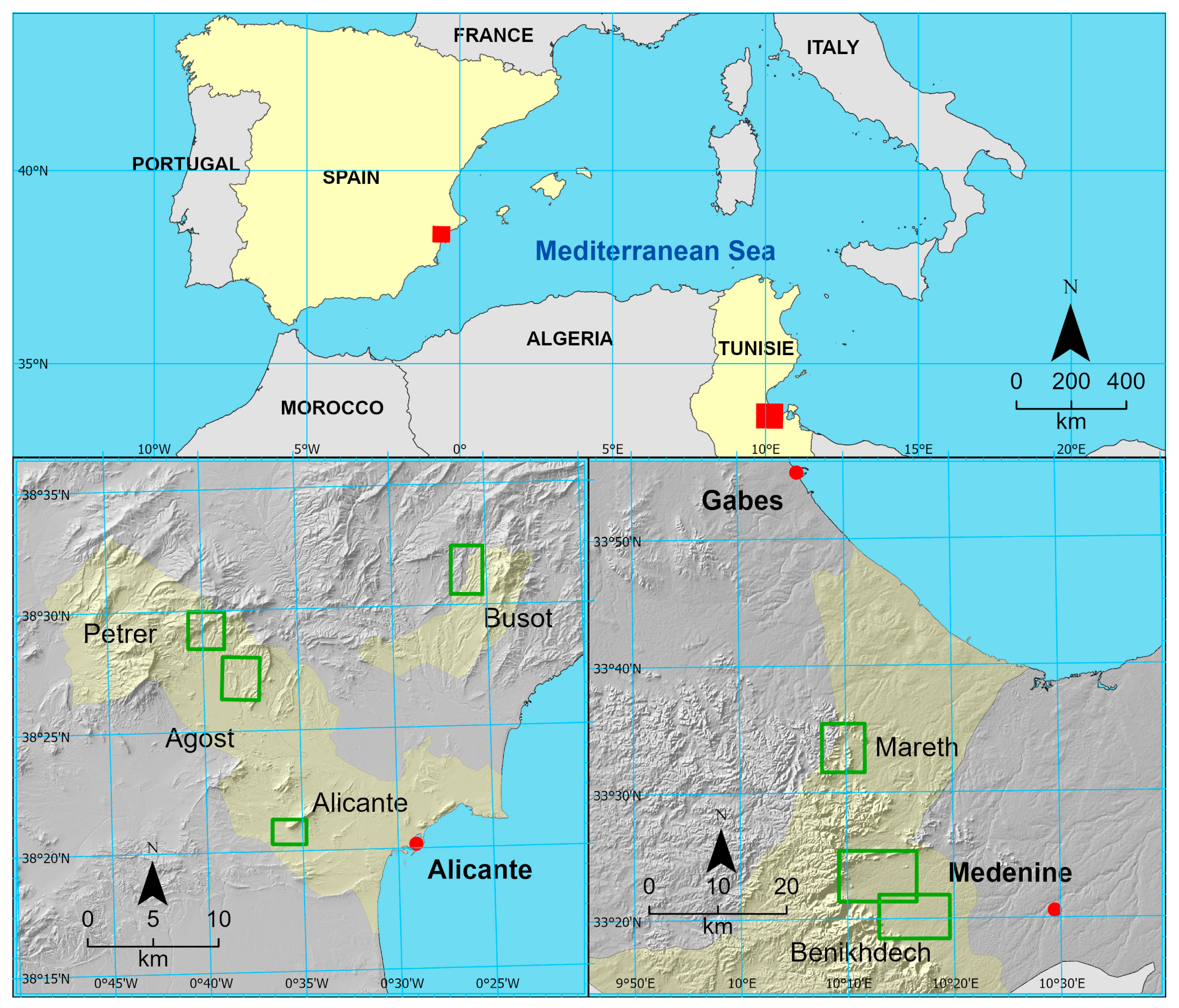
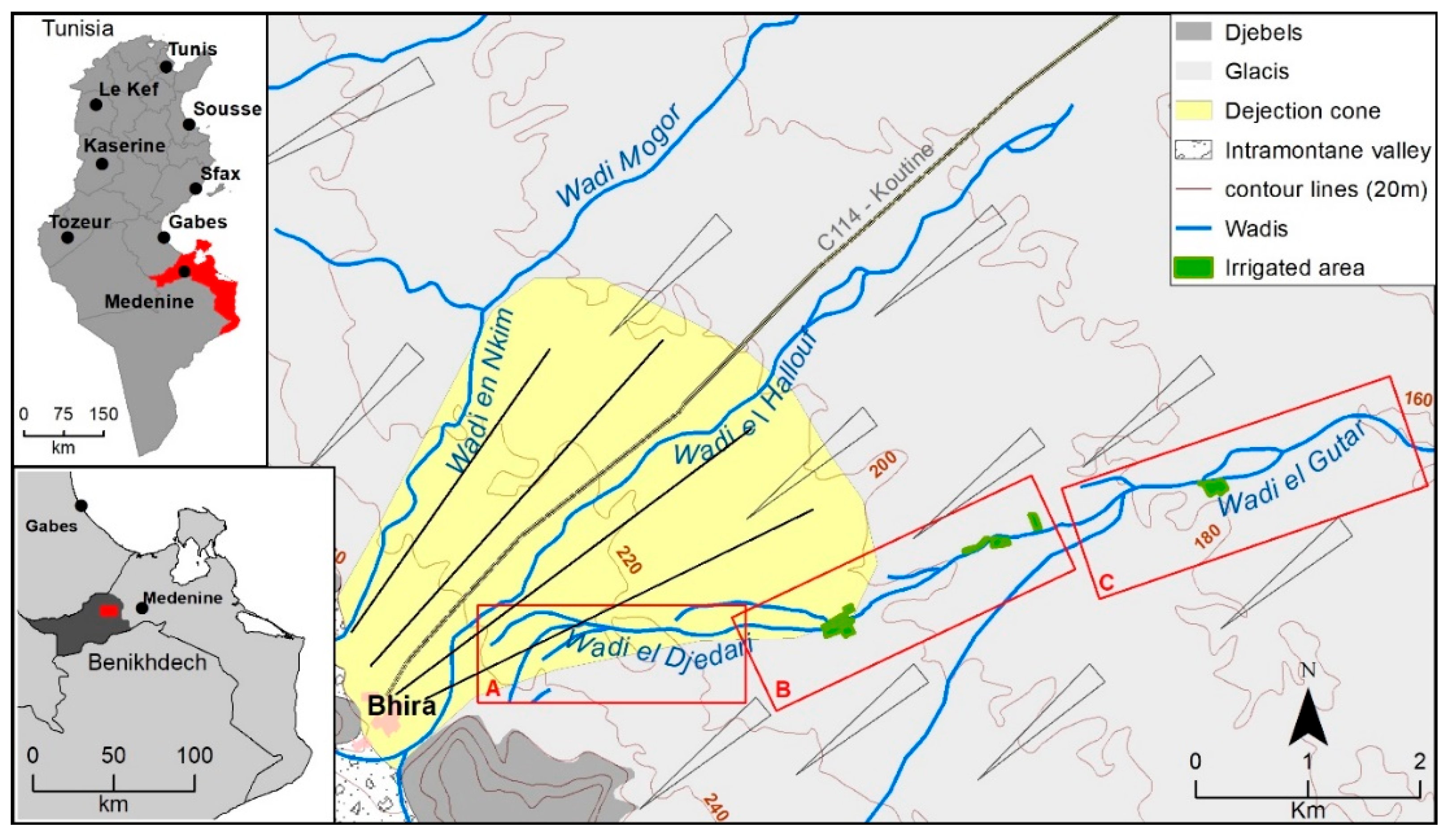
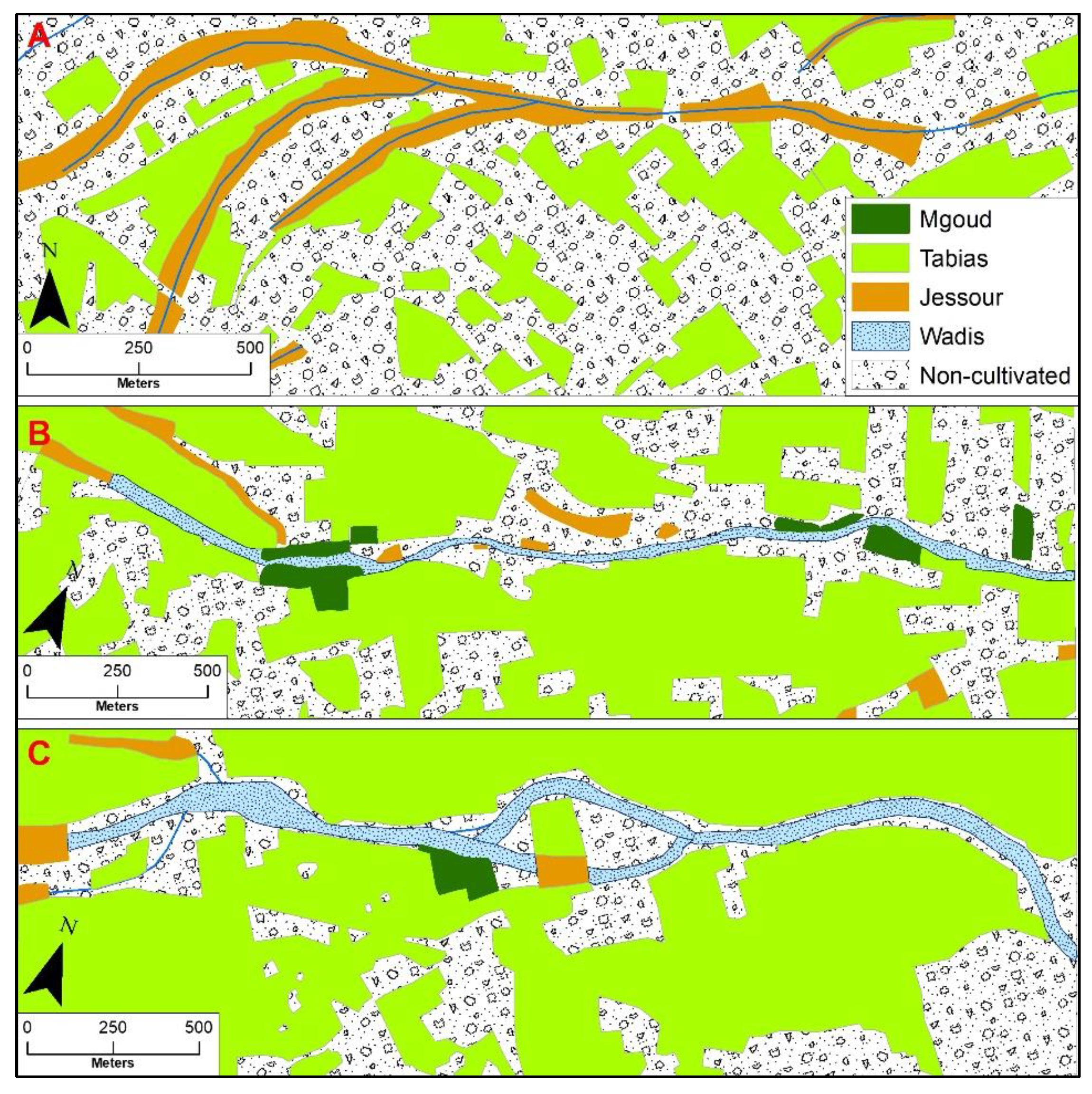
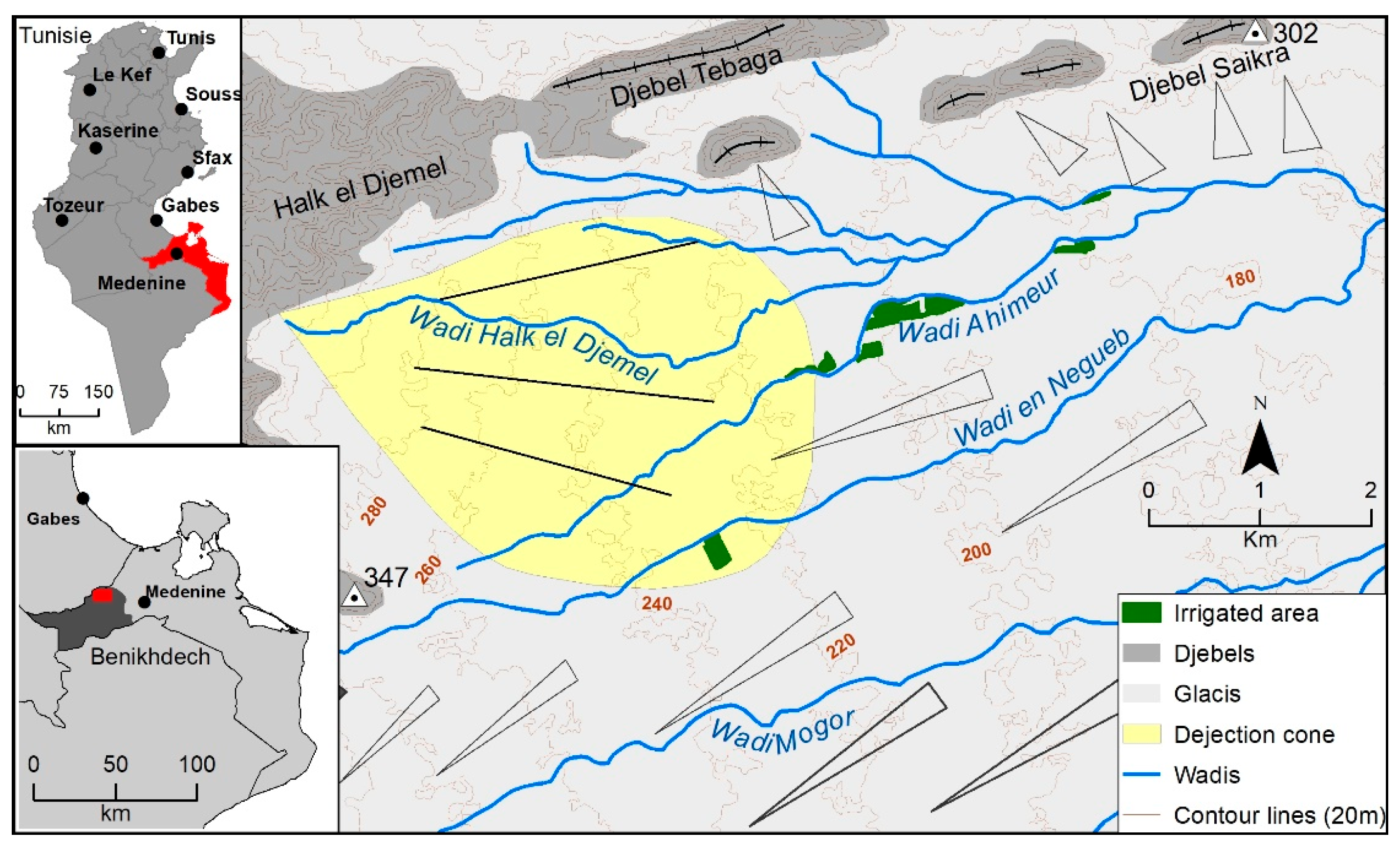
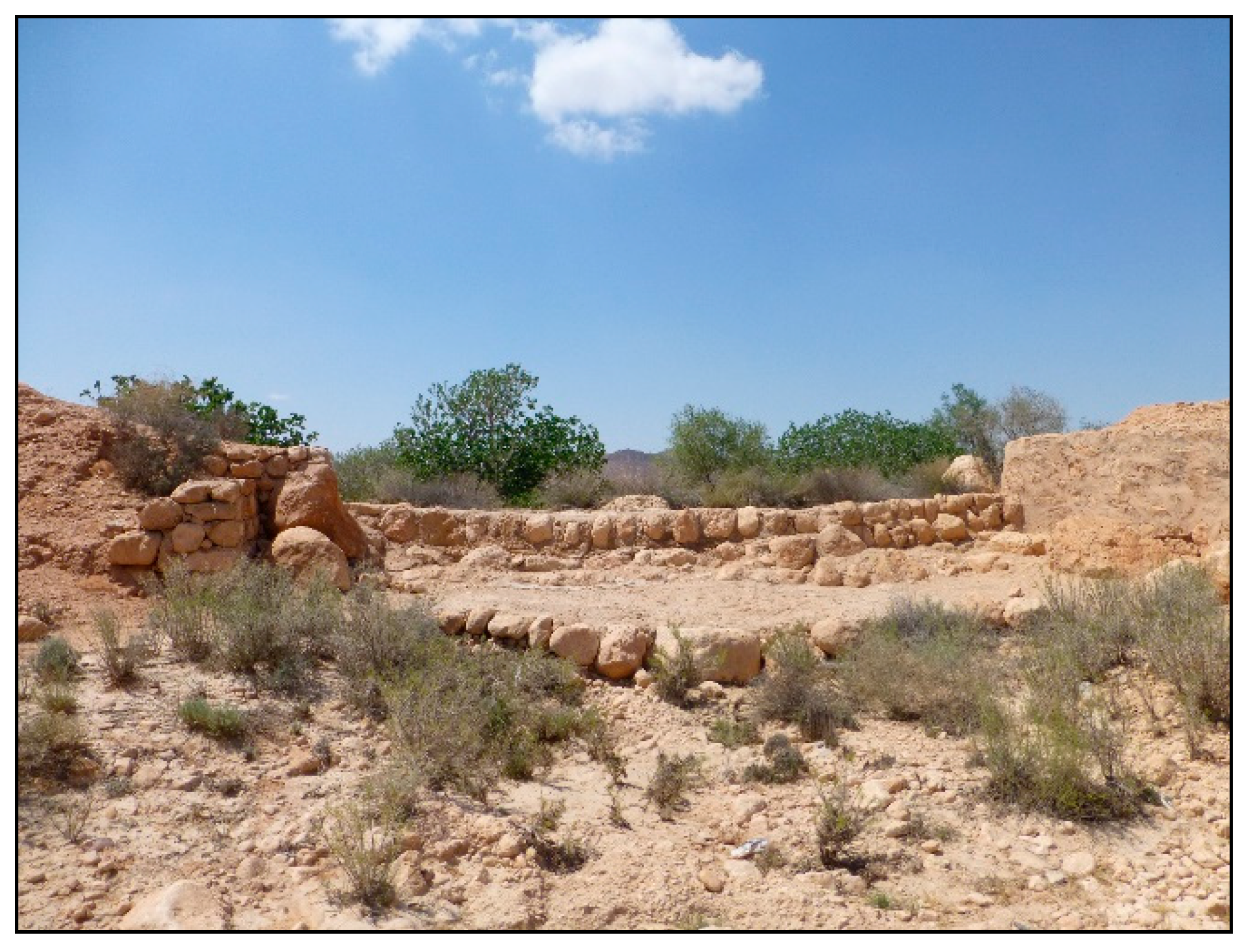
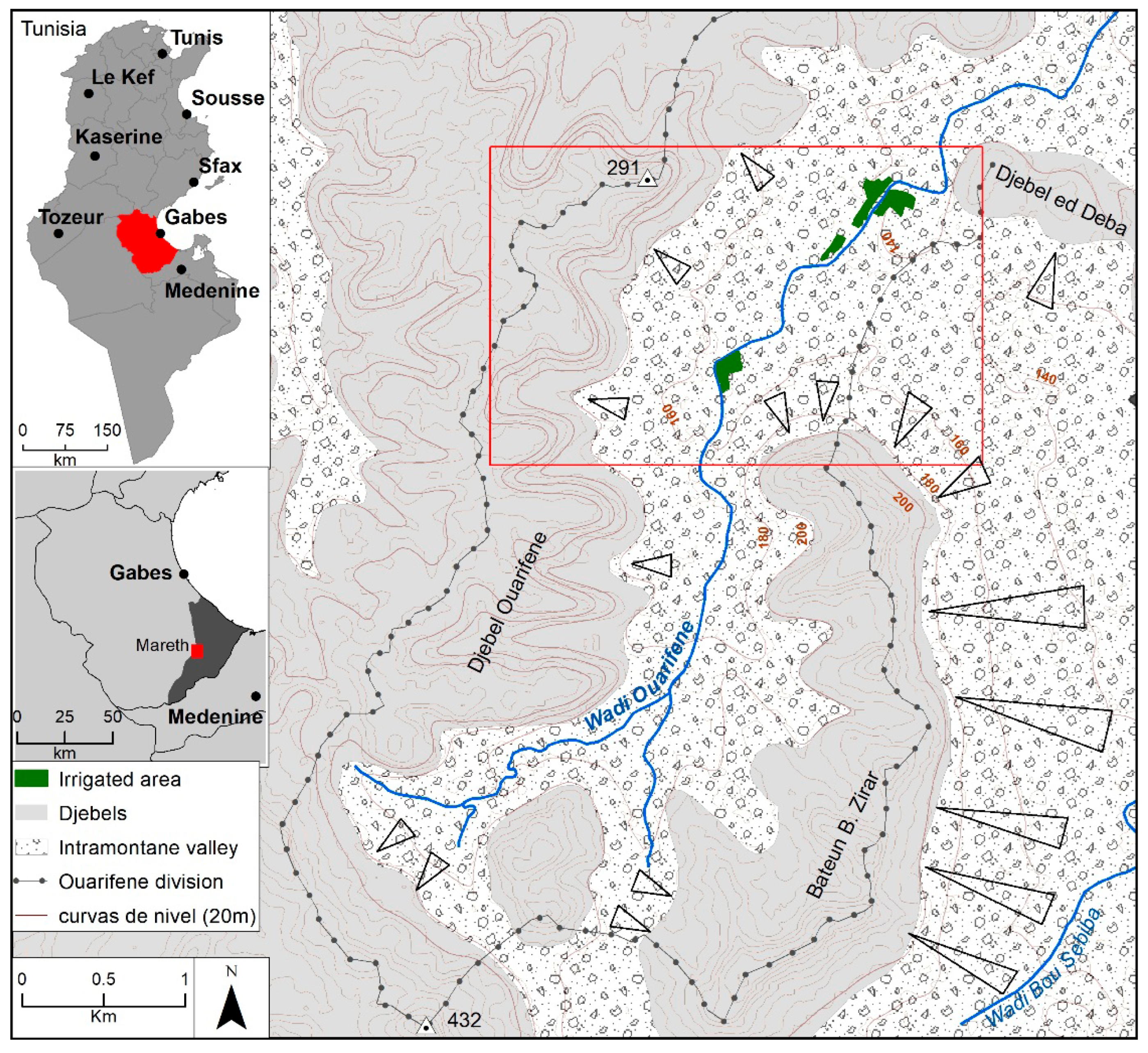
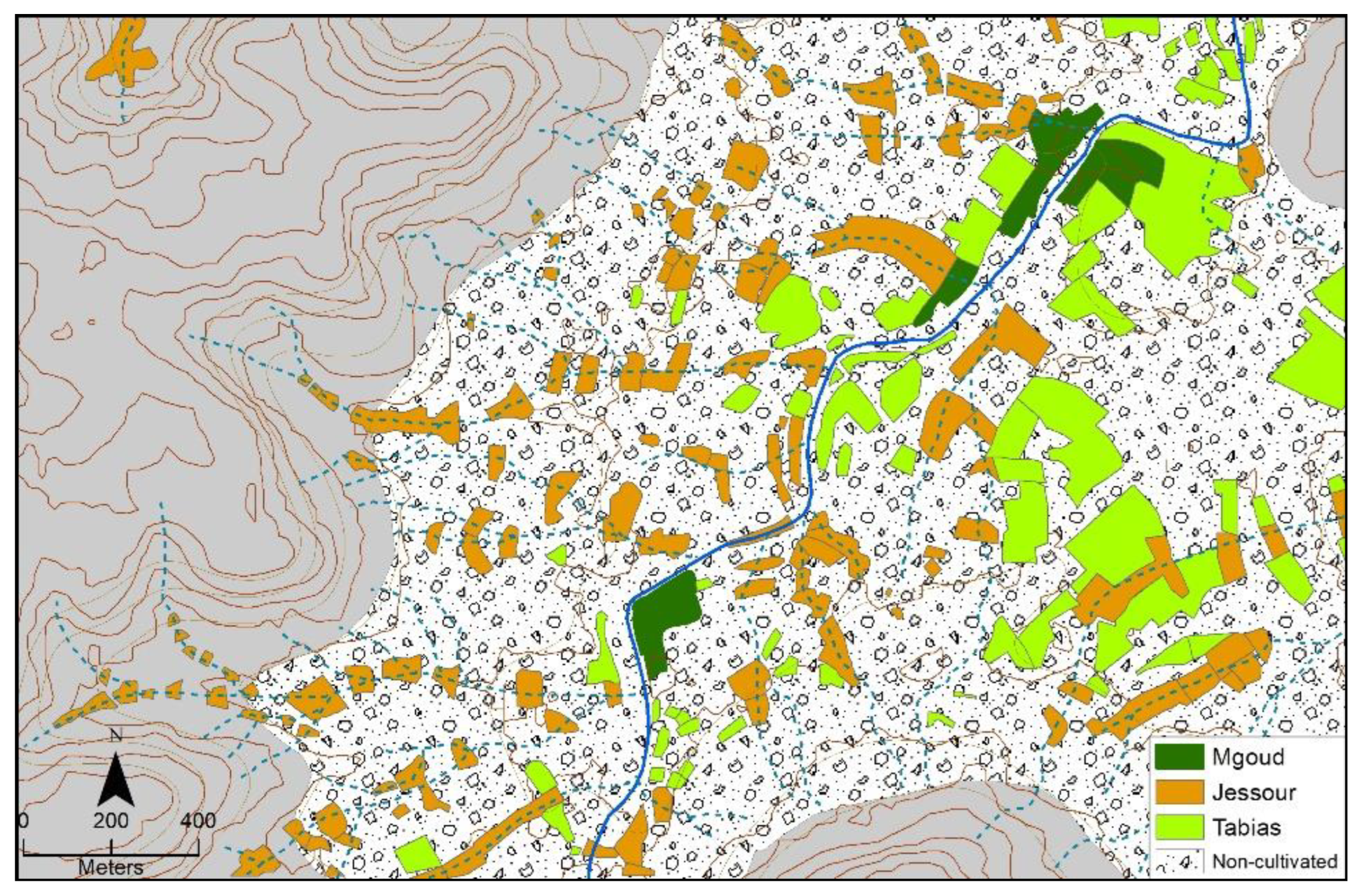
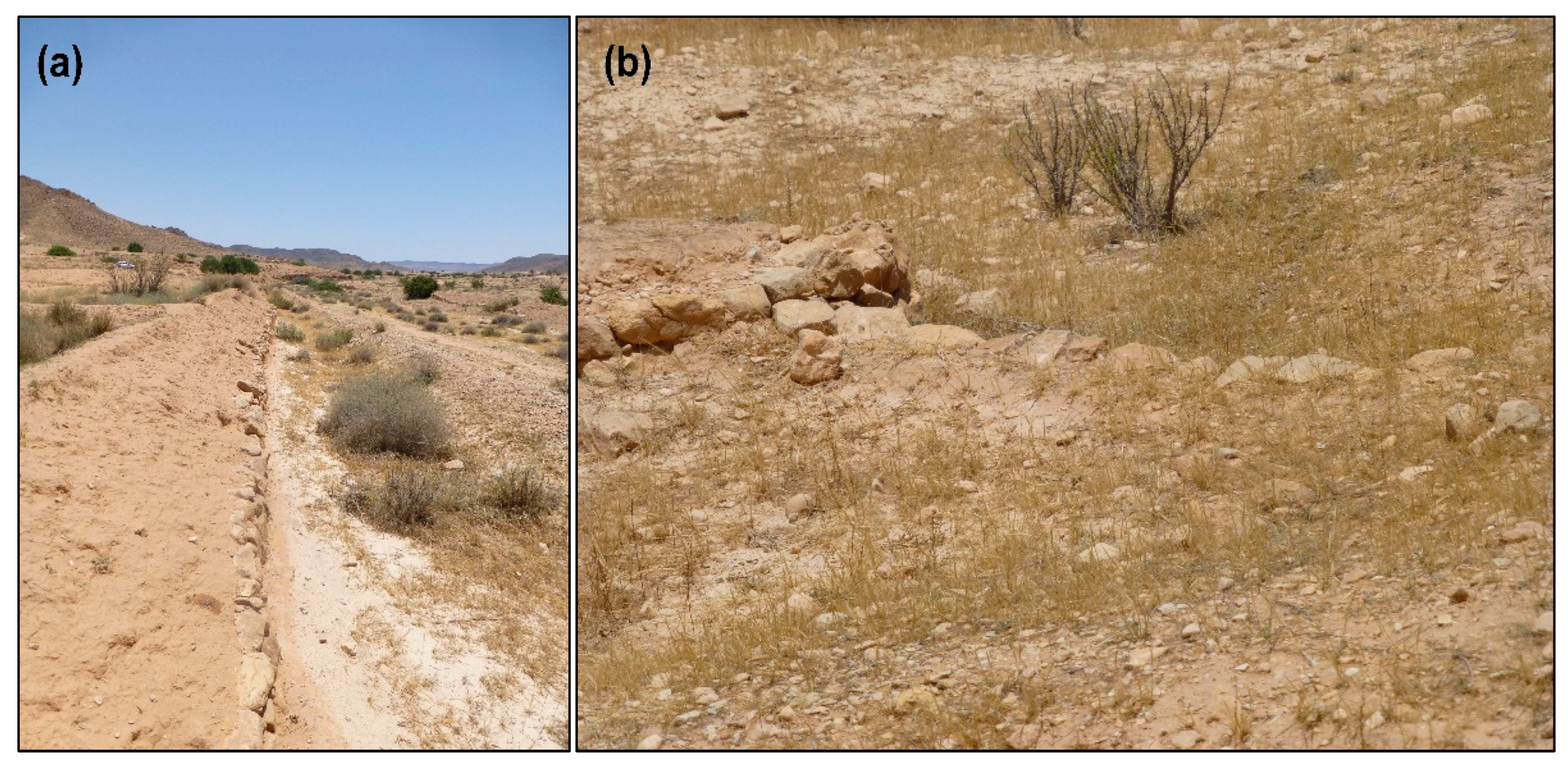
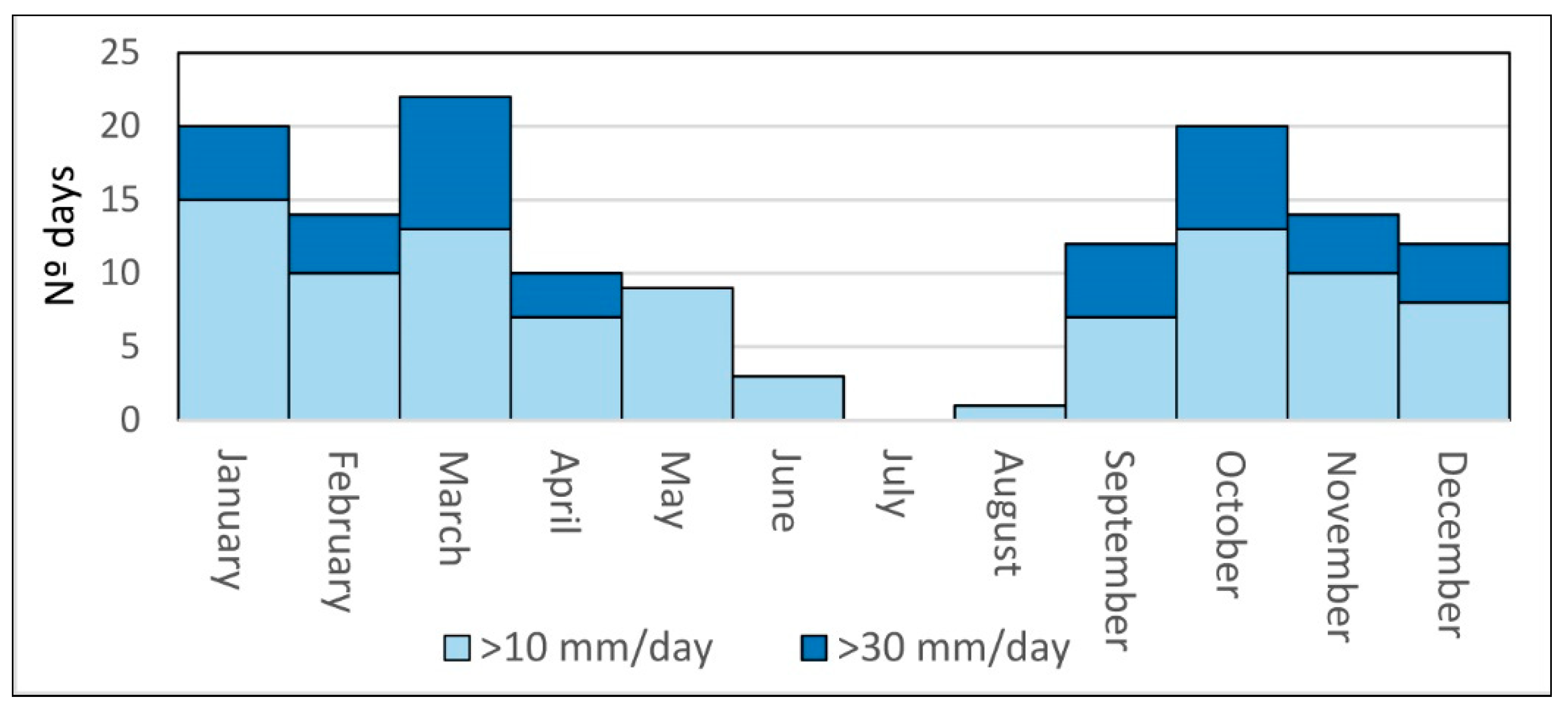
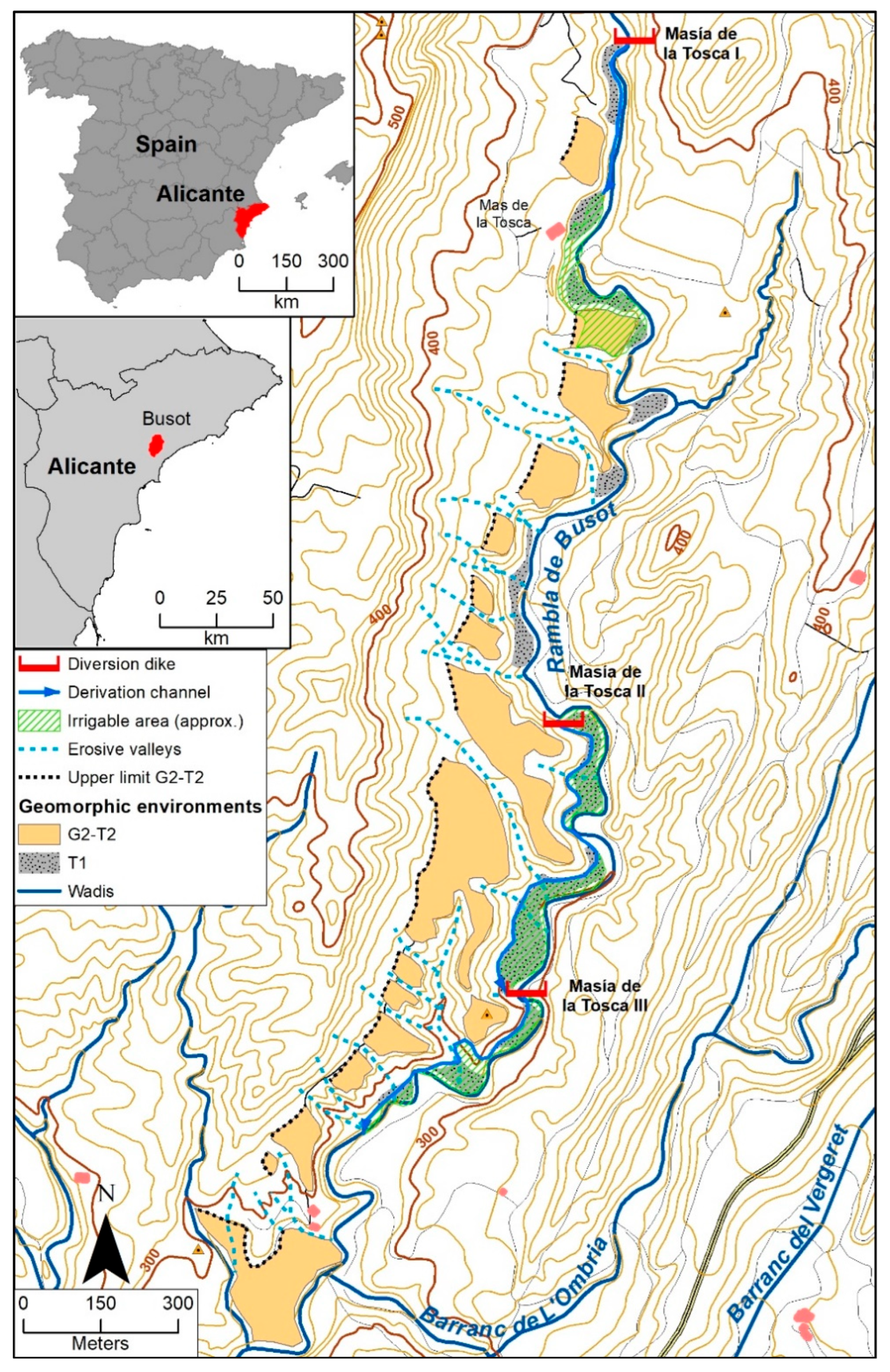
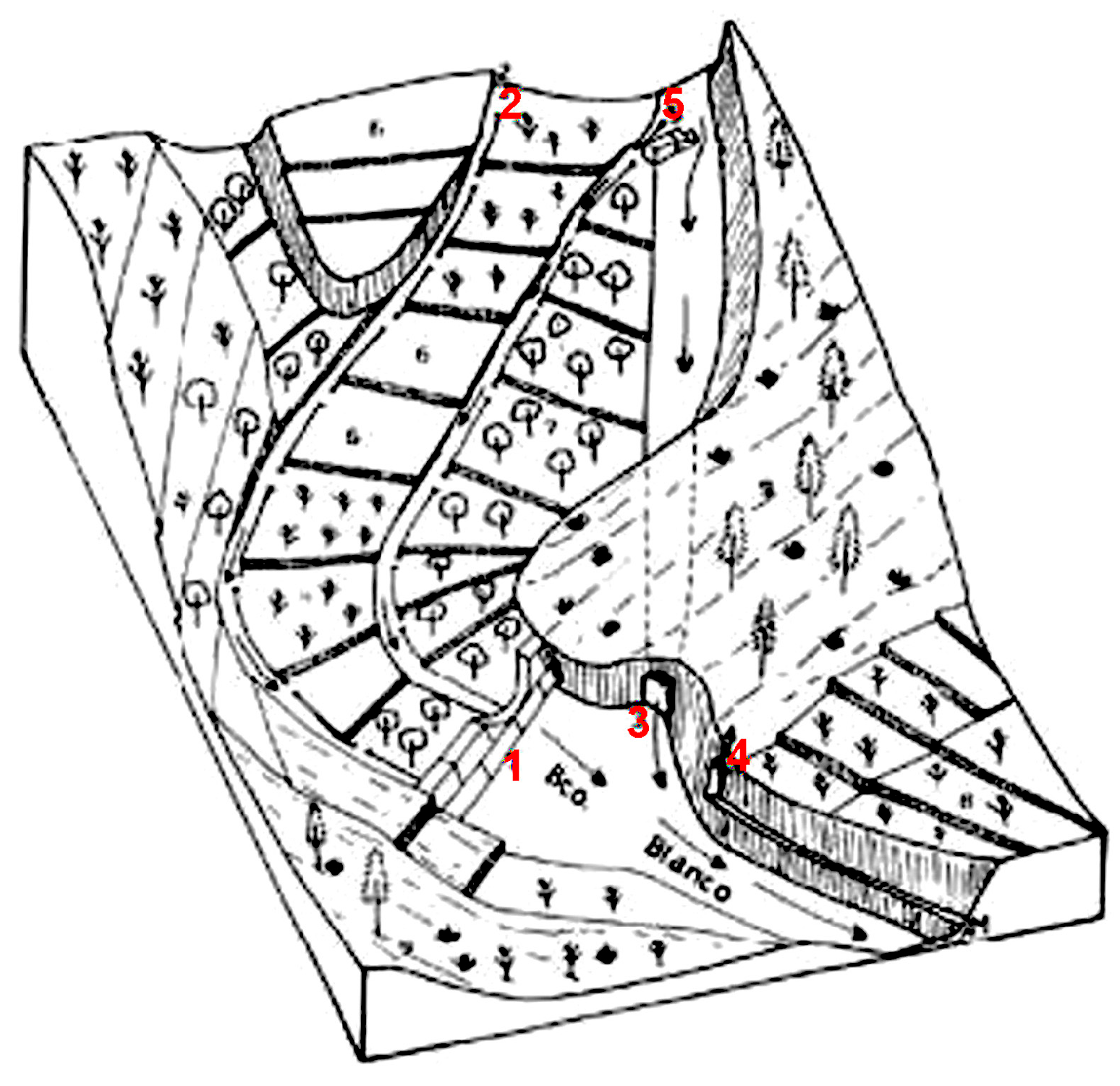
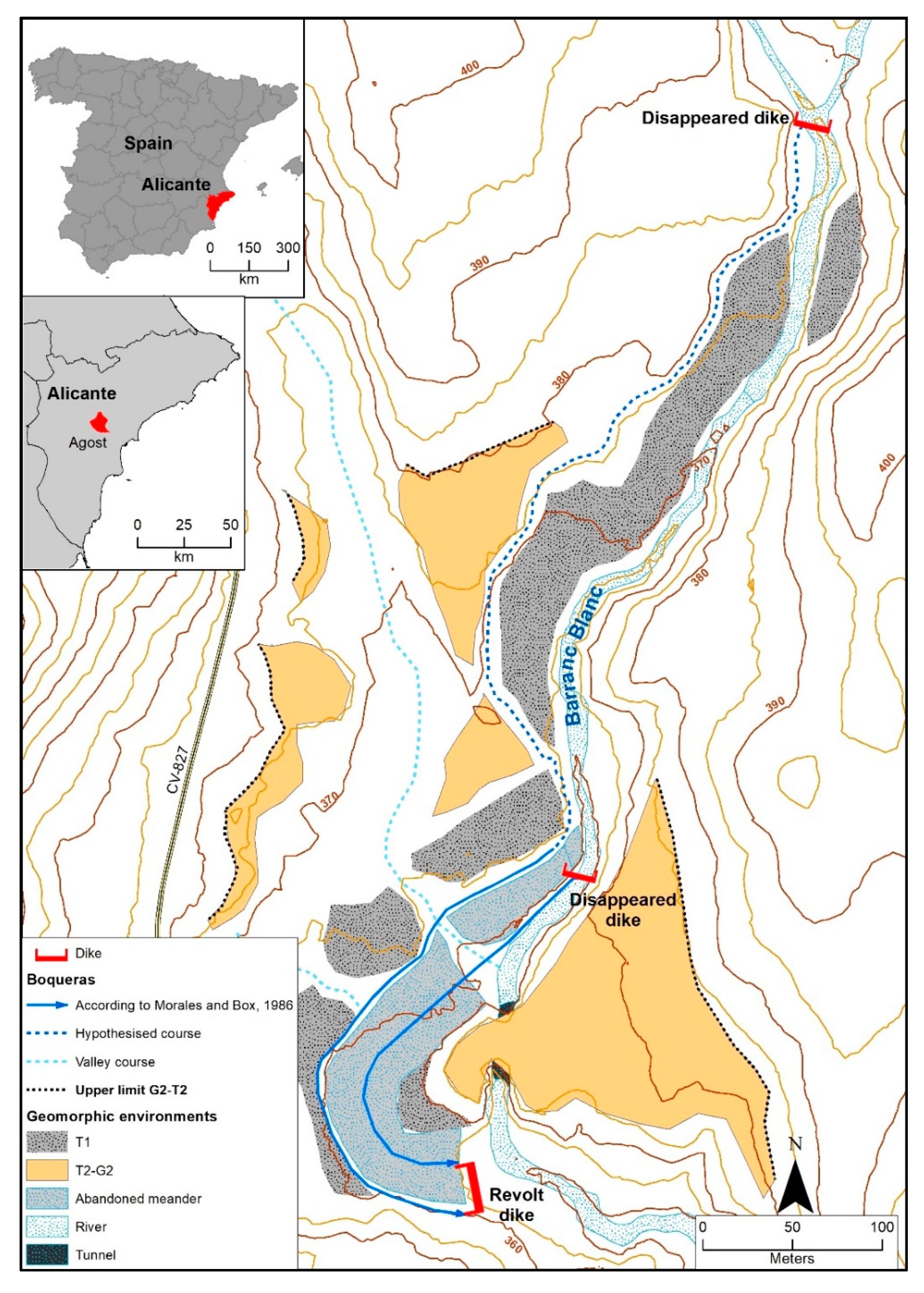
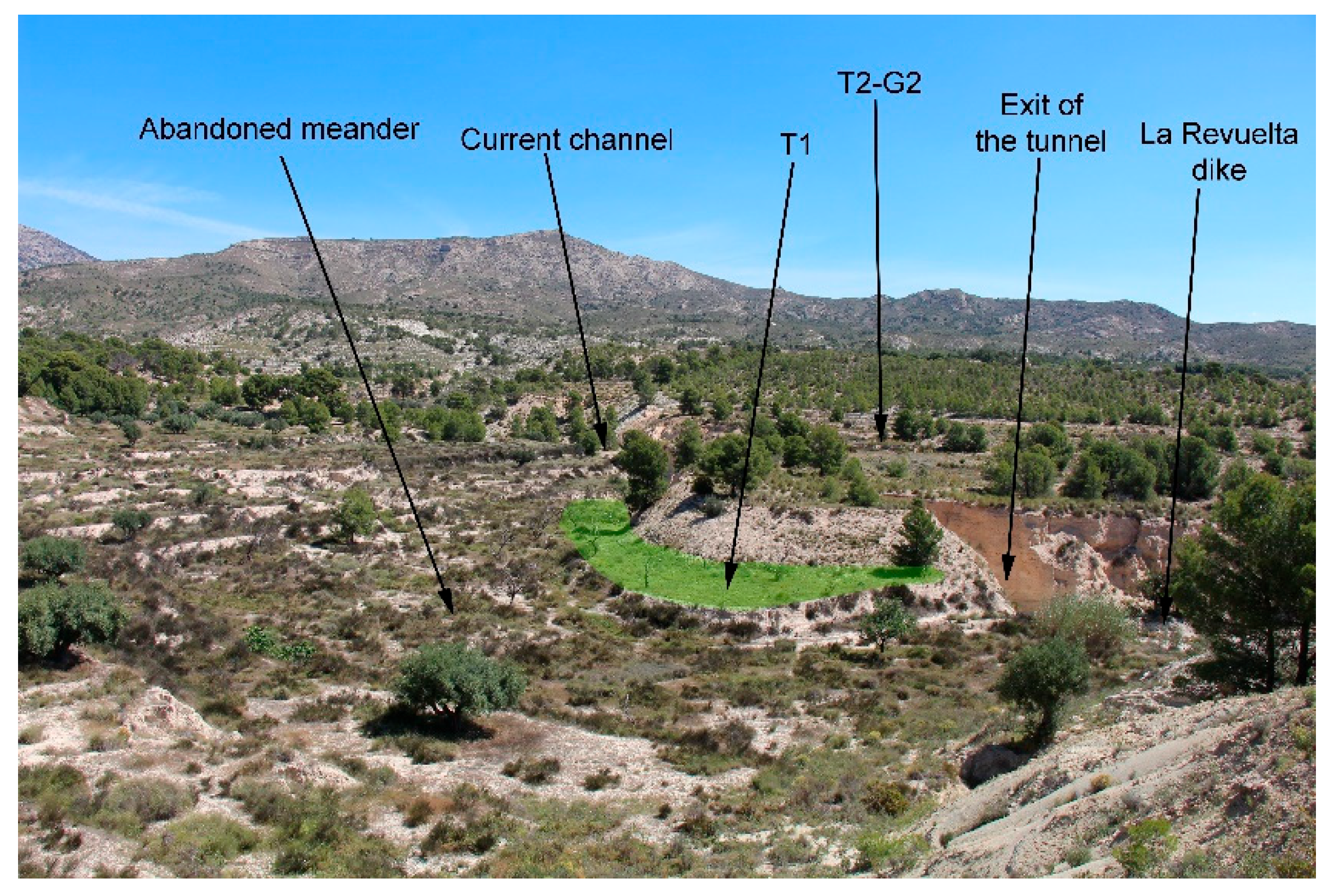
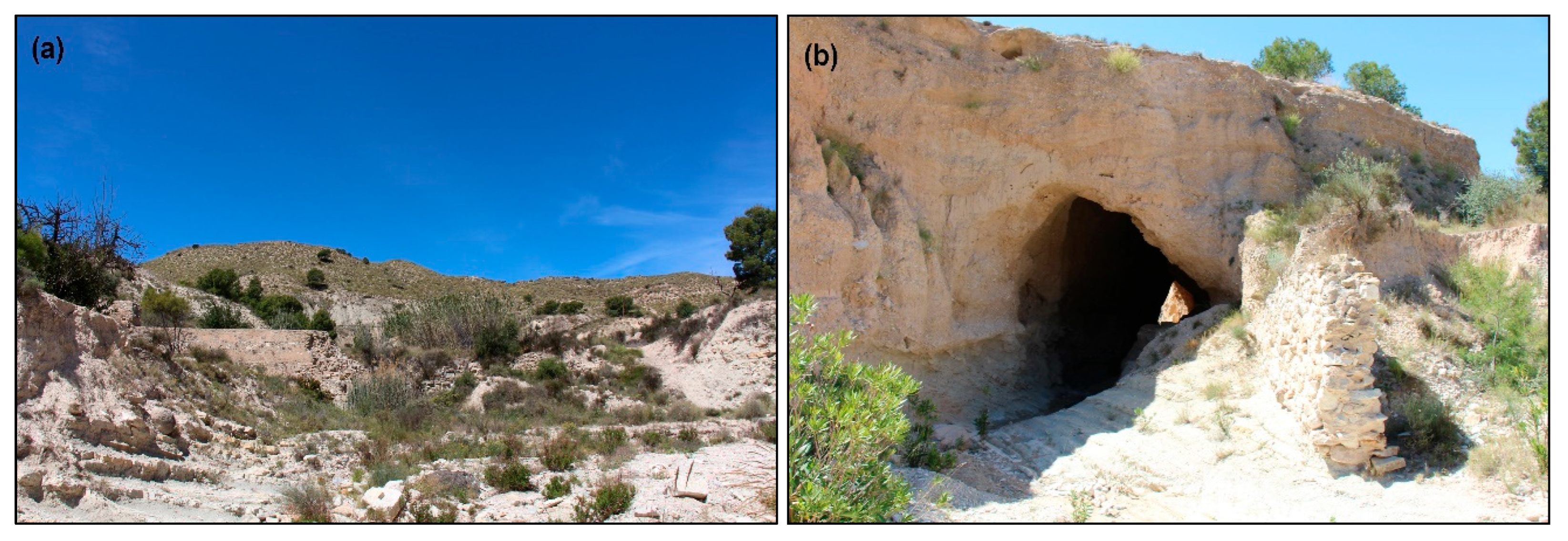
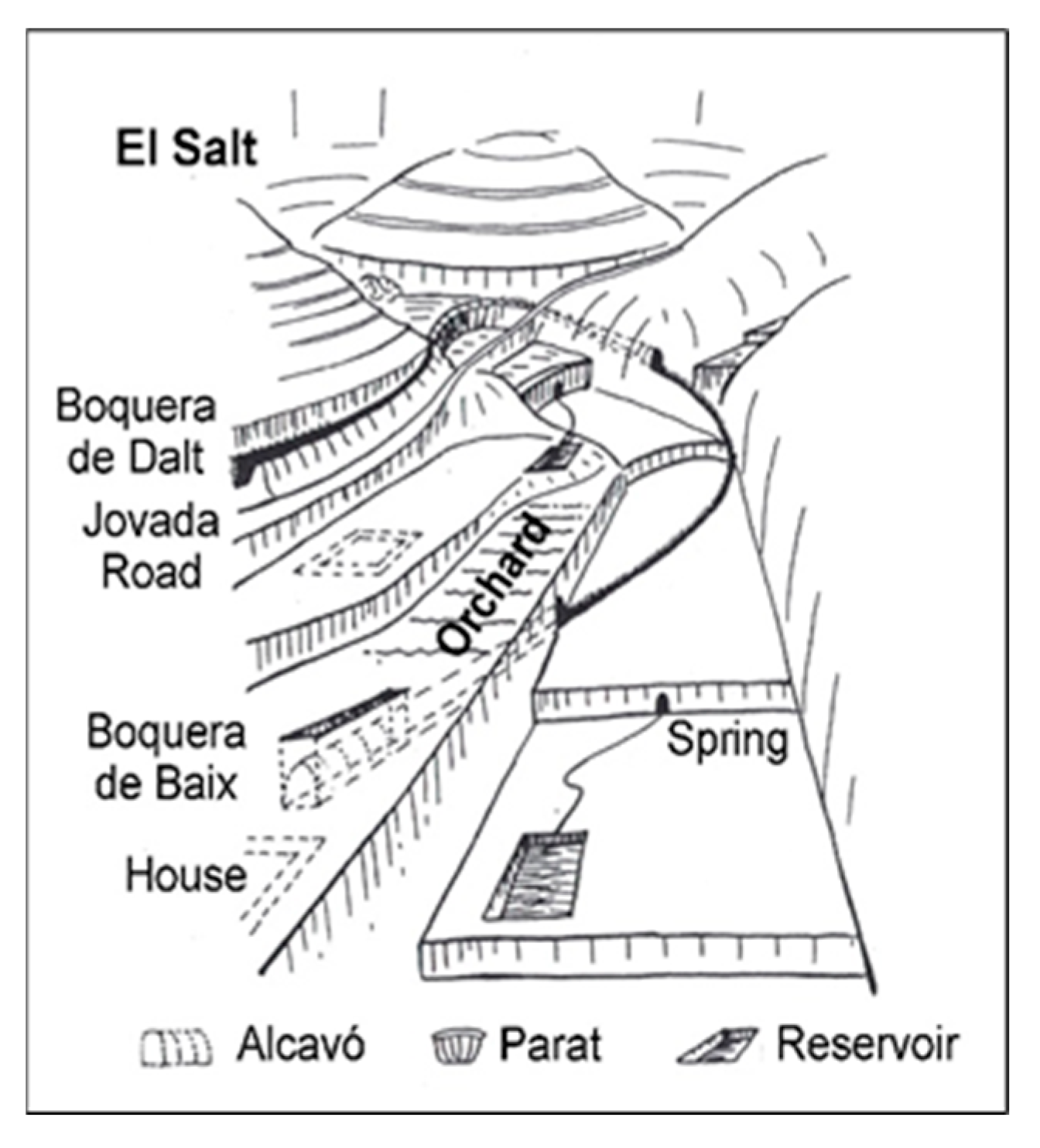

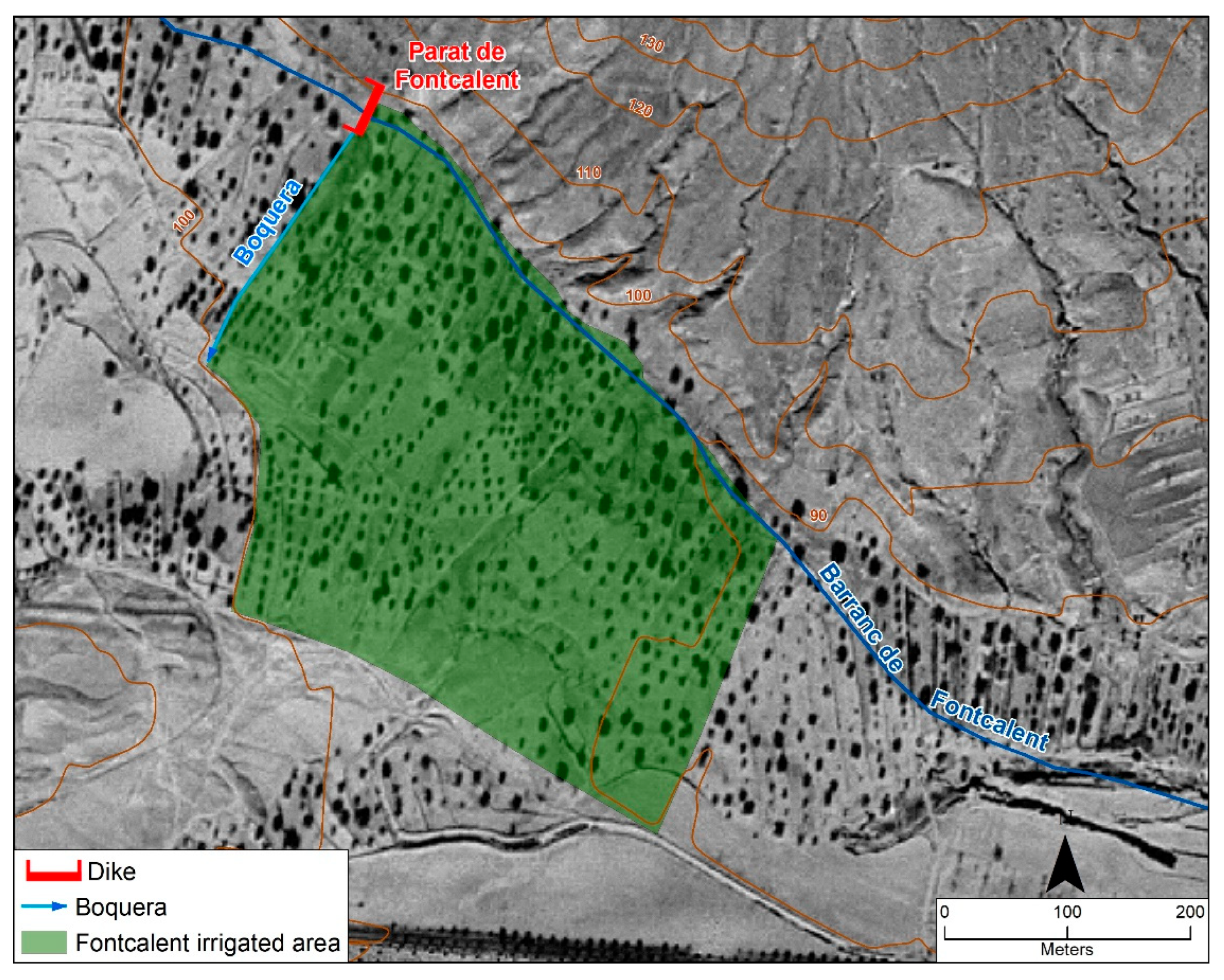
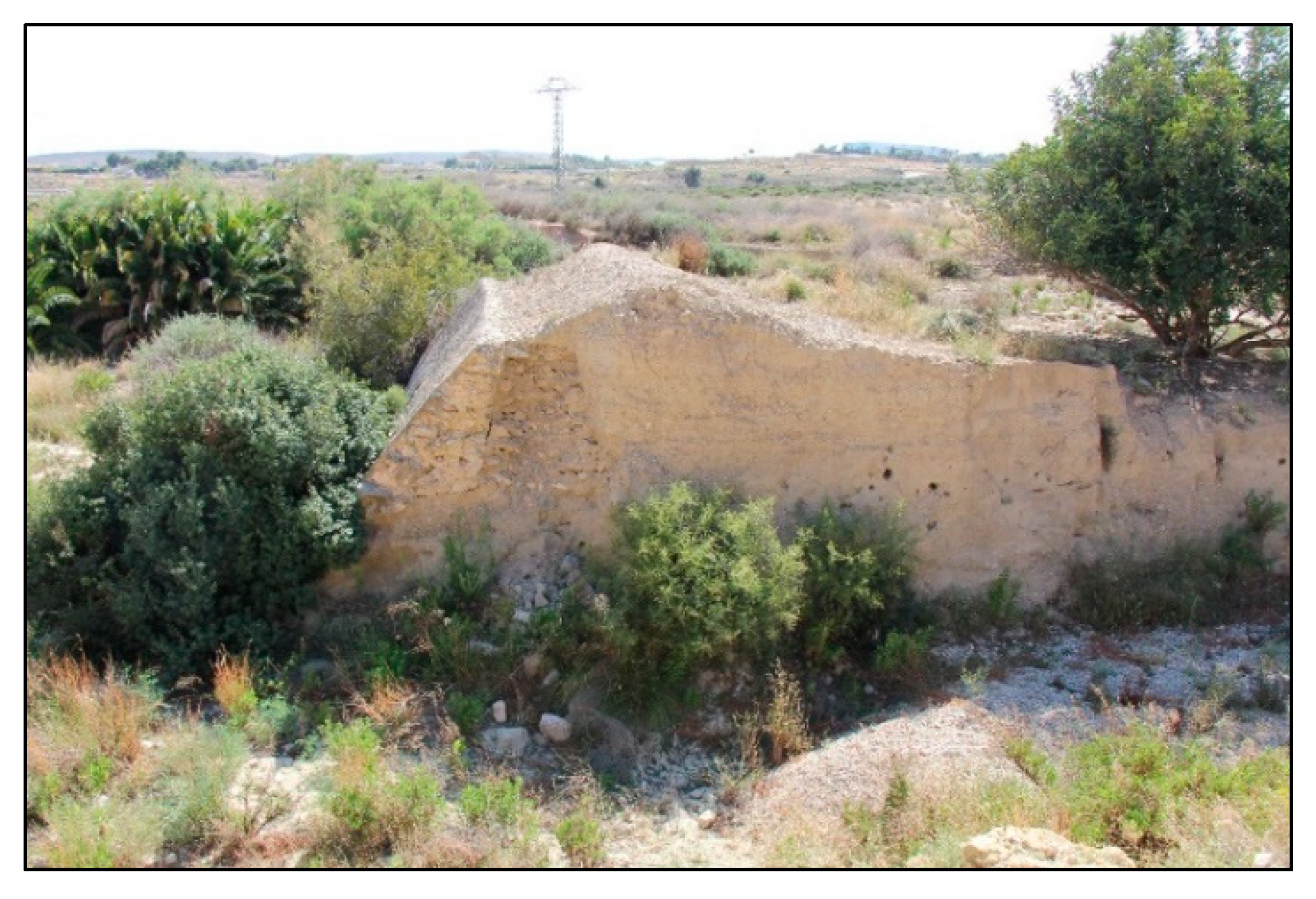
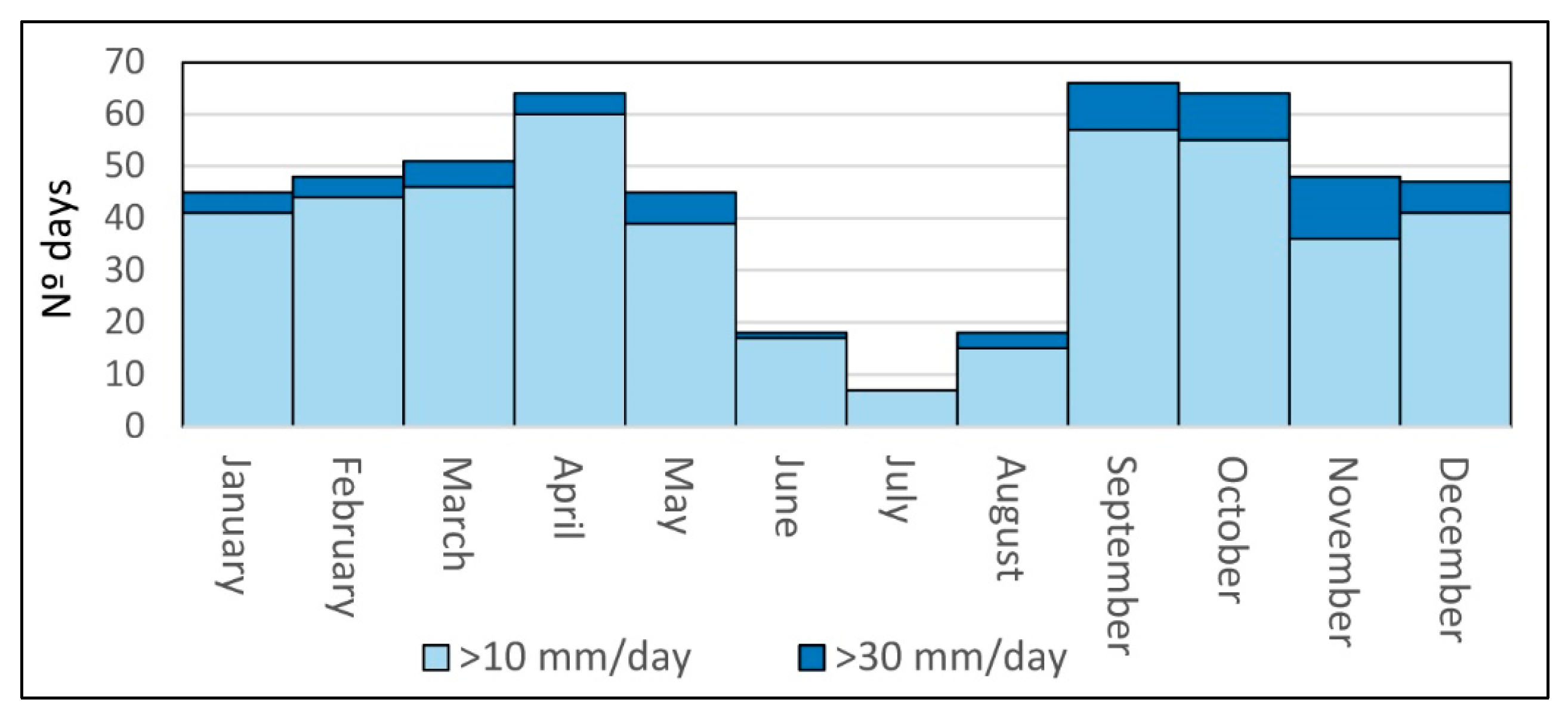
| Mgoud | No. | Mean Area (ha) | Max. Area (ha) | Min. Area (ha) |
|---|---|---|---|---|
| Bhira | 6 | 1.22 | 2.01 | 0.54 |
| Ahimeur | 8 | 2.93 | 7.36 | 0.41 |
| Ouarifene | 6 | 1.16 | 2.10 | 0.72 |
Disclaimer/Publisher’s Note: The statements, opinions and data contained in all publications are solely those of the individual author(s) and contributor(s) and not of MDPI and/or the editor(s). MDPI and/or the editor(s) disclaim responsibility for any injury to people or property resulting from any ideas, methods, instructions or products referred to in the content. |
© 2025 by the authors. Licensee MDPI, Basel, Switzerland. This article is an open access article distributed under the terms and conditions of the Creative Commons Attribution (CC BY) license (https://creativecommons.org/licenses/by/4.0/).
Share and Cite
Fansa-Saleh, G.; Pérez Cueva, A.J.; Iranzo-García, E. Comparative Analysis of Runoff Diversion Systems on Terraces and Glacis in Semi-Arid Landscapes of Spain and Tunisia. Geographies 2025, 5, 32. https://doi.org/10.3390/geographies5030032
Fansa-Saleh G, Pérez Cueva AJ, Iranzo-García E. Comparative Analysis of Runoff Diversion Systems on Terraces and Glacis in Semi-Arid Landscapes of Spain and Tunisia. Geographies. 2025; 5(3):32. https://doi.org/10.3390/geographies5030032
Chicago/Turabian StyleFansa-Saleh, Ghaleb, Alejandro J. Pérez Cueva, and Emilio Iranzo-García. 2025. "Comparative Analysis of Runoff Diversion Systems on Terraces and Glacis in Semi-Arid Landscapes of Spain and Tunisia" Geographies 5, no. 3: 32. https://doi.org/10.3390/geographies5030032
APA StyleFansa-Saleh, G., Pérez Cueva, A. J., & Iranzo-García, E. (2025). Comparative Analysis of Runoff Diversion Systems on Terraces and Glacis in Semi-Arid Landscapes of Spain and Tunisia. Geographies, 5(3), 32. https://doi.org/10.3390/geographies5030032






